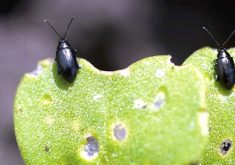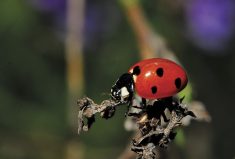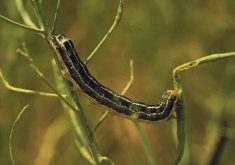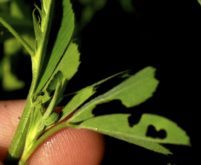Insect pressure dropped in 2020, and Alberta producers can expect much the same for 2021.
“In general, 2020 wasn’t really a big insect year, especially compared to past years,” said Boyd Mori, an assistant professor of agricultural and ecological entomology at the University of Alberta.
“We had flea beetle pressure like we always do, but a lot of the pests that we often deal with retreated a little bit in 2020.
“It seems like most species are going to be average this year too.”
But that will depend on what you’re growing and where you’re growing it, said Mori. For many of Alberta’s insect pests, researchers are still trying to figure out their overwintering capacity, but generally, populations decline during a really cold winter with limited snow cover.
“But if we get a decent snowpack on the fields, that really helps to insulate the soil where a lot of our insect pests are overwintering,” he said.

So if you’re growing wheat southeast of Edmonton, for instance, wheat midge pressure there could be “potentially heavy.”
“Wheat midge is one that’s been off everyone’s radar for a few years now because it’s been warm and quite dry,” he said. “But in 2020, it was quite moist, so I think in 2021, we could see a boom population of wheat midge, especially in that region.”
Grasshoppers are also cause for concern in north-central and northern Alberta this year. Last year, southern Alberta farmers saw heavier grasshopper populations around Lethbridge down toward the border, but in other regions, “grasshoppers were almost non-existent.”
That could flip this year, with heavier grasshopper pressure in northern Alberta, as one of the species in the Parkland region appears to be on a two-year life cycle.
Read Also

New crop insurer policy enables easier startup for faba beans
Agriculture Financial Services Corporation updated its normals for faba beans, which may open the door for more Canadian producers to feel comfortable growing the pulse crop in the future.
“In 2019, we saw high grasshopper numbers in the Peace Region and north-central region,” said Mori. “If it weren’t on a two-year life cycle, we’d expect to see high numbers, but we saw absolutely nothing.
“So for 2021, we’re expecting to see some grasshoppers again in those regions.”
Southern Alberta producers should also keep an eye out for a common insect pest in the region — wheat stem sawfly.
“It was noted by a few agronomists in the County of Forty Mile that there was up to 70 per cent cutting caused by sawfly,” he said. “The survey from last fall also showed there was quite high cutting, so growers in that region should definitely be considering a solid-stem variety to combat sawfly.”
Flea beetles are likely to be a problem no matter where you are in Alberta, he added.
“Everyone is always worried about flea beetles. It’s kind of our annual pest that everybody has to deal with.”
Last year, producers reported seed treatments weren’t effective against flea beetles at the high-population levels, forcing some to spray.
“That seems to be the case most years now. There are just some really high populations of flea beetles,” said Mori. “But there’s at least one new seed treatment coming out on the market this year for flea beetle control, so I think we’ll be seeing producers using more and more of those newer seed treatments.”
The Prairie Pest Monitoring Network offers forecasts and risk maps that are based on the previous year’s insect population. Producers in regions with higher populations last year should be on the lookout this year as well.
“My advice is the same as always — scout, scout, and scout,” said Mori. “Depending on the pest, there’s the potential it could wipe out the crop, and there’s nothing to replace just being out in the field and taking a look.
“I know farmers have larger and larger farms and they have less and less time to do those things, but it’s very, very important for them to be out there having a look.”
For this year’s insect forecasts and risk maps, visit prairiepest.ca.















